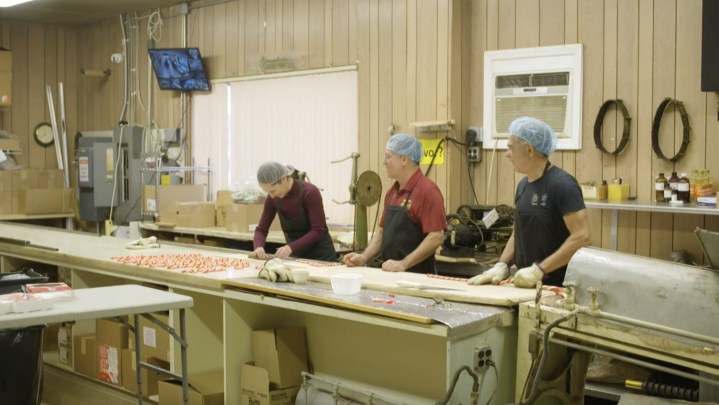
Candy cane producers feel the bite of rising sugar prices

This story was produced by our colleagues at the BBC.
When the holiday season rolls around, Dave Giambri’s candy shop in Clementon, New Jersey, is bustling. Customers are flocking to Giambri’s Quality Sweets for the candy canes.
Giambri’s candy canes are made almost entirely of sugar — and all are made by hand. The sugar mix is folded and prodded and twisted into that famous red and white pattern.
This year, the main ingredient is costing Giambri more.
“I did have a slight 4% to 5% increase on the final product,” he said. “I want to say sugar went up maybe 15% from last year.”
He’s not the only one feeling the pinch. The cost of sugar is rising worldwide — and it’s rising in the U.S., where protectionist policy props up domestic producers.
Louisiana, the home of sugarcane
The U.S. is the world’s fifth largest sugar producer, with sugarcane grown in the South and sugar beets in the North. The U.S. is also a top consumer.
To find out more, we went to the land of Mardi Gras and jazz bands. Why? Because Louisiana is also the home of sugarcane. We drove an hour and a half west of New Orleans to visit one farm.
Louisiana is the northernmost point where sugarcane is grown commercially. About a mile away from the Mississippi River, thousands of years of flooding have left naturally occurring, fertile topsoil perfect for growing sugarcane.

Patrick Frischhertz is a sugarcane farmer in Plaquemine, Louisiana. He explained how sugar goes from being something grown there to something ready to buy at the store.
“We’ll plant a whole stalk in the ground, and the following year, we’ll go through the bill at harvest or harvest that cane. It goes into an 18-wheeler, goes to the mill, and the mill presses the juice out of that stalk of sugarcane,”
The mill is the middleman between the farm and the refinery. It’s where the sugarcane starts to look like the sugar we keep in our kitchens.
Charlie Schudmak, chief operating officer of Core Texas Sugar Mill, in White Castle, Louisiana, revealed the huge effort needed to process the cane:
“Sugarcane’s like a sponge. You have to wet it and squeeze it — except it’s stubborn, it doesn’t want to give out that juice,” he said. “So it takes out about 800 tons of force on top of the cane to squeeze all that juice out.”

Does U.S. sugar production policy work?
The Department of Agriculture protects domestic sugar production from foreign competition by taxing imports. An October report by the Government Accountability Office found that the sugar program creates higher prices and that Americans pay around twice the world price for sugar.
While the sugar farmers benefit, it’s not like they don’t have other problems.
“Last year we had a very good crop,” said farmer Patrick Frischhertz. “The problem was input costs were, quite frankly, through the roof. Potassium, for example, $198 a ton went to $1,000 a ton.”
“You have to apply that nutrient to the crop, so you have to take that hit. So even though it could be a great crop with an average or even above average price for your commodity, you’re still feeling the squeeze, and there’s almost no way to plan for it,” he added. “Our farm and American sugar farmers in general will outcompete anybody in the world. We just can’t compete against a farmer receiving direct subsidies.”
Supply and demand

Back in New Jersey, Dave Giambri’s sugar supply is waiting in bags to become one of his famous peppermint candy canes. He’s one of the few still making them by hand.
“Most of them are made overseas because of the price on sugar and labour,” Giambri said. “Not many are made in the States. It’s a dying art, it really is.”
As we watched customers put candy canes and chocolate goodies into their baskets, he told me he thinks Americans are willing to pay up to satisfy their sweet tooth.
“When prices go up, I just increase prices. Gas prices rise up, people still drive. They’re still going to buy a candy cane for their tree, whether they pay 10 cents or a dollar for it,” he said. “It’s something that makes Americans feel good.”
Correction (Jan. 5, 2023): A previous version of this story misspelled Patrick Frischhertz’s name.
There’s a lot happening in the world. Through it all, Marketplace is here for you.
You rely on Marketplace to break down the world’s events and tell you how it affects you in a fact-based, approachable way. We rely on your financial support to keep making that possible.
Your donation today powers the independent journalism that you rely on. For just $5/month, you can help sustain Marketplace so we can keep reporting on the things that matter to you.











